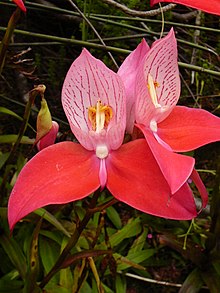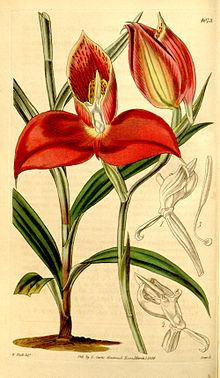Disa uniflora
| Disa uniflora | |
|---|---|

| |
| Scientific classification | |
| Kingdom: | |
| (unranked): | |
| (unranked): | |
| Order: | |
| Family: | |
| Subfamily: | |
| Tribe: | |
| Subtribe: | |
| Genus: | |
| Species: | D. uniflora
|
| Binomial name | |
| Disa uniflora | |
| Synonyms | |



Disa uniflora is a species of orchid in the Orchidaceae family.[1][2] It is the type species of the genus Disa, and one of its best-known members. It is also referred to as the red disa, the pride of Table Mountain, and occasionally by its old name Disa grandiflora.[1][3] Its current name is nevertheless Disa uniflora.[1][2][3][4] Its range is restricted to the Sandstone Mountains of the South Western Cape, South Africa, west of Hermanus to Table Mountain[4] and northwards into the Cederberg Mountains.[2] It is common on Table Mountain, and the Back Table, but is rarely seen further south on the Cape Peninsula.[1] The orchid grows near waterfalls, streamlets, and seeps in the mountains.[1][2] It is, however, never found along the shores of dams whose water levels vary considerably during the year.
It is a fairly stout perennial 15 – 60 cm in height, spreading by stolons. The leaves are lance shaped, the lower ones spreading or semi-erect up to 25 cm long. The inflorescence is 1-3 flowered. The blooms are showy, and can be 10 cm across the laterally spreading sepals, which are scarlet to carmine in color. The middle, upright sepal is pinkish on the inside with scarlet veins.[1] The petals, which are very much smaller than the sepals, are erect colored yellow with red spots at their tops, but pale scarlet at their bases.[1] It blooms during the summer months, particularly in January, but continuing into March.[1][2][3][4] Its pollination is one of the most complex of all the orchids, involving the mountain pride butterfly, Aeropetes tulbaghia.[1]
The Mountain Club of South Africa, the Western Province Rugby Team and the Western Cape Gymnastics Association use the image of this species on their badges and logos. It has been the Mountain Club's logo since its founding in 1891. The flowers are also depicted on the obverse side of the Pro Merito Medal (1975).
References
- ^ a b c d e f g h i j Trinder-Smith, Terry (2006). "Orchidaceae". Wild Flowers of the Table Mountain National Park. Kirstenbosch, Claremont: Botanical Society of South Africa. pp. 104–105. ISBN 1874999600.
{{cite book}}: Cite has empty unknown parameter:|lpg=(help) - ^ a b c d e Manning, John (2007). "Disa". Field Guide to Fynbos. Cape Town: Struik Publishers. pp. 162–163. ISBN 9781770072657.
{{cite book}}: Cite has empty unknown parameter:|lpg=(help) - ^ a b c Maytham Kidd, Mary. (1983). "Orchidaceae". Cape Peninsula – South African Wild Flower Guide 3. Kirstenbosch, Claremont: Botanical Society of South Africa. pp. 40–41. ISBN 0620067454.
- ^ a b c Burman, Lee; Bean, Anne (1985). "Orchidaceae". Hottentots-Holland tot Hermanus – Veldblomgids van Suid-Afrika 5. Kirstenbosch, Claremont: Botanical Society of South Africa. pp. 68–69. ISBN 0620083956.
{{cite book}}: Cite has empty unknown parameter:|lpg=(help)
External links
 Media related to Disa uniflora at Wikimedia Commons
Media related to Disa uniflora at Wikimedia Commons Data related to Disa uniflora at Wikispecies
Data related to Disa uniflora at Wikispecies
